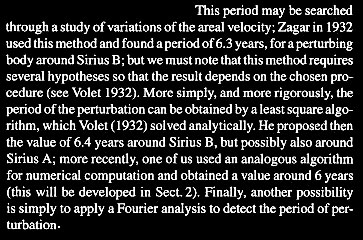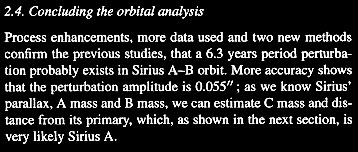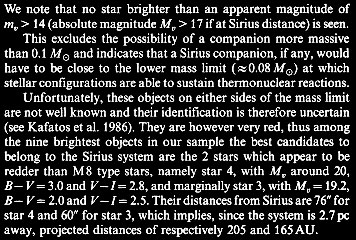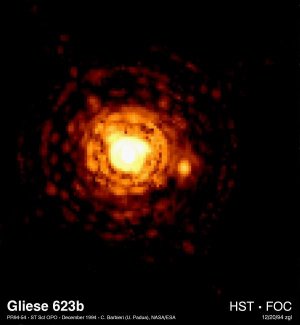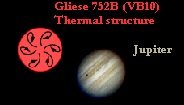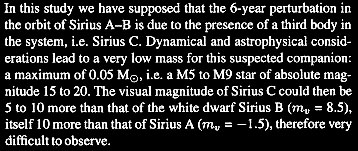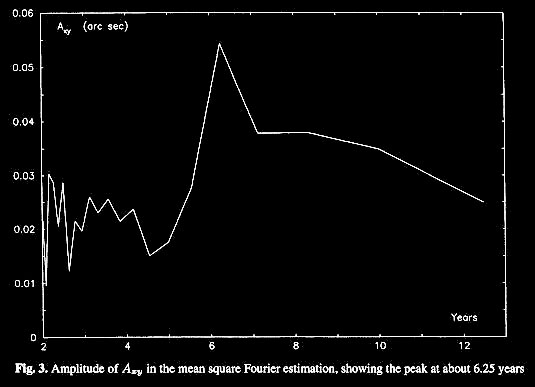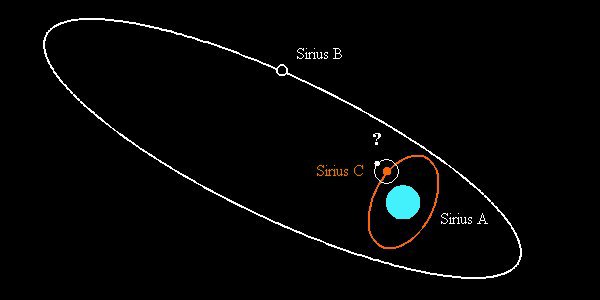|
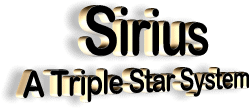
How true is it in
terms of astronomy?
from The
DogonAndSirius Website
Sirius C exists
|
From 'Un
Systeme Soudanais de Sirius'
The paper enumerates a number of astronomical statements
as follows (links to Astronomical Tests):
-
"The orbit describing
Digitaria around Sirius is perpendicular to the
horizon" -- p280
-
"When Digitaria is
close to Sirius, it becomes most brilliant; when it
is furthest away, Digitaria gives a scintillation
which the observer believes as many stars." -- p281
-
"The period of the
orbit is counted double, that is 100 years." -- p282
-
"Besides its movement
of translation, Digitaria turns on itself in a
year." -- p283
-
"The Star [Digitaria],
which is white, where Sirius is seen as red, is the
origin of all things." -- p284
-
"The contents of the
recipient star are ejected by centrifugal force, in
the form of infinitely small parts comparable to
grains of Digitaria developing quickly: 'The things
exiting to outside the star become as big as it
every day.'" -- p286-7
-
"Digitaria is the
smallest of all things, and the heaviest star" --
p287
-
"It [Digitaria] is
composed of a metal named sagala, a little brighter
than iron, and of a weight that everyone on earth
cannot lift it. The star weighs 480 mule loads
(about 35,000 kg), or all grains, or all the iron on
earth, if they were theoretically the size of a
stretched cow hide or a mortar board." -- p287
-
"But Digitaria is not
the sole companion of Sirius: the star emme ya,
'Sorghum Female,' more voluminous than it, but four
times lighter than it, follows a vaster trajectory
in the same direction and the same time as it (50
years). Their respective positions are where their
rays make right angles." -- p287
-
"It [emme ya] also
emits rays which have the quality of solar rays." --
p288
-
"it [emme ya] is
accompanied by a satellite which is named "star of
Women," nyan tolo" -- p288
These statements are
supported by the following diagram, among others:
Nyan aduno tonu (Drawing of the World of Women) or
Anduno dale donule tolo (Drawing of the Heights and
Depths of the World) -- p290
This is the drawing that kicked off 50 years of
controversy. This most compelling feature of Un Systeme
Soudanais de Sirius claims to give a overview of the
whole Sirius system, an executive summary of the
foregoing statements. True size is about twice this.
|
 |
- S: Sirius
A (sigi tolo -- "Star of Yasigi")
- Da-b: Sirius B, the "egg of the world," at extreme orbital positions (po
tolo -- "Star of Fonio")
- E: Sirius C (emme ya tolo -- "Star of Sorghum Female") showing "rays"
surrounding it. "Put at the centre of the egg as
the Sun at the centre of the solar system."
- Fa: Sirius C's planet (nyan tolo -- "Star of Women"). The small spiral
shows it is a satellite of "Sorghum Female."
- Fb: "Sign of women"
- Fc: "Sex of women"
- R, N: Mythical personages:
- R: Yurugu, the Fox
- N: Nommo, the Fish |
This is one of the "raw
documents" which Griaule and Dieterlen were so eager to
share. The style of presentation of Un Systeme Soudanais
de Sirius is in fact better described by Claude
Meillassoux.
"Far from taking the form of verbatim transcriptions in
the native language, they combine translations of brief
quotations with paraphrases, interpretations and
commentaries… it is practically impossible to
distinguish between what originates from the informants
and what comes from the anthropologist."
|
We should not be surprised. To quote a
conservative source, the Harvard Bright Star Catalog:
"C, companion to B at 1.4" suspected
but not confirmed"
It says this sort of thing for a
thousand stars where the suspicion is probably correct.
One support for the existence of Sirius C is as an
explanation for the historical "Red Sirius."
Bonnet Bidaud and Gry say:
After Sirius B was discovered in 1867, the following statement is
relevant.
|
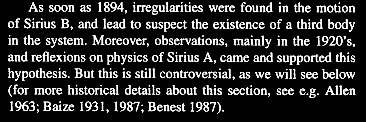
Benest and Duvent
|
Observations of Sirius C in the 1920s:
|

Benest and Duvent
|
Details of the 1920s Observations:
"As for a third star, Phillip Fox
reported in 1920 that the image of Sirius B had appeared to be
double, using the same 18 1/2 inch refractor with which Clark
discovered B. R.T.Innes in S. Africa and van
den Bos, a renowned double-star observer, also reported the
3rd star. I should note here that these were visual studies, and
the object in question is at the very limit of what can be
observed with a telescope. "
-- Tom Randolph
This was the knowledge available in
1950.
In 1973 I.W.Lindenblad (author of the first photographs
of Sirius B) of the U.S. Naval Observatory concluded that there was
no astrometric evidence for a 3rd star, and this seemed to shut the
case for a while, along with the authoritative statements of Sirius
C skeptics Gatewood and Gatewood, who took detailed measurements of
B.
However, the question is still taken seriously by professional
astronomers, for other reasons, and in 1995 was published
Is Sirius a
Triple Star?,
by D. Benest and J.L. Duvent. Astronomy and
Astrophysics 299, 621-628 (1995) Their case is based on orbital
analysis of A and B.
Despite Lindenblad's observational
failure, three independent mathematical methods with updated and
more accurate orbital data show a perturbation of 6.3 years, which
B&D hypothesize to be the orbital period of the third body,
Sirius C.
They say it must be a red/brown dwarf of 0.05 Mo, and offer
suggestions to observe it in the infra-red spectrum "within 3" of
Sirius A." In the paper about Red Sirius, Bonnet-Bidaud &
Gry make
an observation of Sirius' stellar field by masking the great
brightness of Sirius A.
They come up with several candidate objects for Sirius C.
Benest and Duvent say,
There is also an amount of indirect collateral evidence for Sirius
C. Red dwarfs are a common class of star but generally small and
faint, and hard to observe.
Hence the surprise at the 1997 discovery that one was rather close
by:
Follows the NASA ADS abstract from
The Solar Neighborhood
IV. Discovery of the Twentieth
Nearest Star System
HENRY, TODD J.; IANNA, PHILIP A.; KIRKPATRICK, J. DAVY; JAHREISS,
HARTMUT
Astronomical Journal
v.114, p. 388-395 (07/1997)
"As part of a RECONS (Research Consortium on Nearby Stars)
effort to discover stars nearer than 10 parsecs, LHS 1565 (GJ
1061; V = 13.03; M5.5 V) has been found to be only 3.7 parsecs
from the Sun using a combination of photometric, spectroscopic
and trigonometric parallax work. It ranks as the twentieth
closest stellar system and underscores the incompleteness of the
nearby star sample, particularly for objects near the end of the
main sequence.
Ironically, this unassuming red dwarf provides a shocking
reminder of how much we have yet to learn about even our nearest
stellar neighbors."
For instance, another pioneering result
of "seeing the faint" occurred in 1994 with discovery of
Gliese
623b.
|
PHOTO RELEASE NO.:
STScI-PRC94-54
RELEASE DATE:
DECEMBER 21, 1994
HUBBLE FINDS ONE OF THE
SMALLEST STARS IN THE UNIVERSE
This NASA Hubble Space Telescope picture resolves, for
the first time, one of the smallest stars in our Milky
Way Galaxy. Called Gliese 623b or Gl623b, the diminutive
star (right of center) is ten times less massive than
the Sun and 60,000 times fainter.
.
(If it were as far away as
the Sun, it would be only eight times brighter than the
full Moon).
Located 25 light-years away in the constellation
Hercules, Gl623b is the smaller component of a double
star system, where the separation between the two
members is only twice the distance between Earth and the
Sun (approximately 200 million miles).
The small star completes one
orbit about its larger companion every four years.
|
|
Test 11
Sirius C has "rays" (flares?)
It has been hypothesized that Sirius C became visible in the 1920s
because of flaring (the observations do not match Benest and
Duvent's orbital data, see above). Red dwarf flaring was discovered
on October 12, 1994 by a team led by Dr. Jeffrey Linsky at
the Joint Institute for Laboratory Astrophysics (JILA)
in Boulder, Colorado, in another observation of faint objects with
the Hubble Space Telescope.
The star Gliese 752b (VB10) and its companion star Gliese 752a make
up a binary system located 19 light-years away in the constellation Aquila. Gliese 752a is a red dwarf that is one-third the mass of the
Sun and slightly more than half its diameter. By contrast, Gliese
752b is physically smaller than the planet Jupiter and only about
nine percent the mass of our Sun.
This very faint star is near the
threshold of the lowest possible mass for a true star (0.08 Mo),
below which nuclear fusion processes cannot take place according to
current models, and "brown dwarf" stars result.
Using Hubble's Goddard High Resolution Spectrograph (GHRS)
to look for solar flares as occur on our own sun, there was surprise
that while the larger red dwarf was flaring as predicted, tiny
Gliese 752b, 0.08Mo, normal temperature 4,500 degsF, also produced a
flare of 270,000degsF, despite not having a radiative core, meaning
that it must have a strong magnetic field or "dynamo."
Hence Sirius C, a star said to be of similar size, could also flare.
|
|

The
Dogon say that emme ya "also emits rays which
have the quality of solar rays" and give these rays the
symbol which must be considered another triumph of
imaginative thinking.
For a star that "might not exist" we have hard
numbers
for mass, size, orbit and even an idea of its internal
structure. |
Test 12
Sirius C is bigger but four times
lighter than Sirius B
|
From 'Un
Systeme Soudanais de Sirius'
-
"But Digitaria is not
the sole companion of Sirius: the star emme ya,
'Sorghum Female,' more voluminous than it, but four
times lighter than it, follows a vaster trajectory
in the same direction and the same time as it (50
years). Their respective positions are where their
rays make right angles." -- p287
|
Benest and Duvent say the star's mass is a maximum of 0.05Mo, rather
less than the Dogon figure of 0.2585Mo. (Taking Sirius B = 1.034Mo)
and later on they add,
As for size, if Sirius C/Sirius B = Jupiter/Earth, then the ratio of
radius size is about 11. So Sirius C is bigger than Sirius B.
Test 13
Sirius C has orbit of 50 (or 32*Renard
Pale) years
Benest and Duvent's figure for the orbit (which is
ipso facto the proof of the star's existence) is mathematically
rigorous: 6.3 years. Rather less than either 50 years and even the
revised figure of 32 years.
Fourier function as used by Benest and Duvent.
Although, with the reddening of Sirius still in mind, Bonnet-Bidaud
and Gry's quote below spells out the conditions for the reddening.
Tests 14-15
Sirius C has a "larger" orbit than
Sirius B
Sirius C orbit is at right angles to that of Sirius B
[HOW CAN WE KNOW??????]
USSS saying Sirius C has a "larger" orbit than Sirius
B has been
interpreted as meaning more an orbit more circular than elliptical.
In this discussion Benest and Duvent cite astronomers J.R.Donnison
and I. P. Williams, who had calculated the hypothetical possibility
of a stable three-body arrangement in the specific Sirius system in
1978.
Early into my quest, Donnison and Williams had been quoted in the
popular paranormal literature by Karl Shuker as supports for
the Dogon contentions and I emailed them about this. Dr. Iwan P.
Williams was gracious enough to send me this email in response.
Thanks for taking the time out to talk to a rank amateur Dr.
Williams!
"At the time (as indeed now) there was a lot of interest in Planets around other stars and the paper mentioned really has to be seen within that context. we had written a number of papers enquiring about the stability of hypothetical systems and a relevant question was whether "planets" could exist within a binary star context. The
Dogon thing came out about that time and it seemed appropriate to ask the same question about Sirius as for a general system,
i.e. could we have a planet in particular given binary system
i.e. Sirius.
The Answer is not that remarkable, yes provided it is far enough away from the binary pair that the changes in gravity is small and it can be closer on average on a circular orbit (Mean distance = minimum distance)"
Tests 16-18
Sirius C has one main planet in
orbit
Orbit of main planet is 30 years (*Renard Pale)
Sirius C has two planets in orbit (*Renard Pale)
Meanwhile, if Sirius C really has a planet, an orbit of 30 years is
surely an over-estimate.
Does true imagination = real facts?
Diagram of Astronomical knowledge
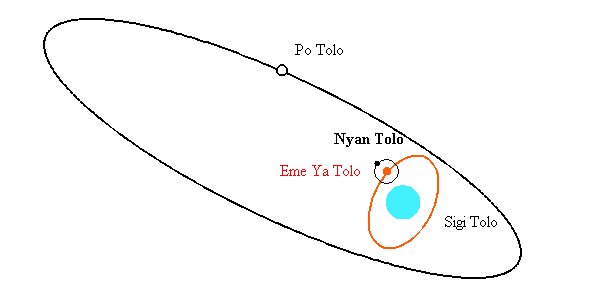
Is Sirius a
Triple Star?
from
TheSAO/NASAAstrophysicsDataSystem
Website
|





